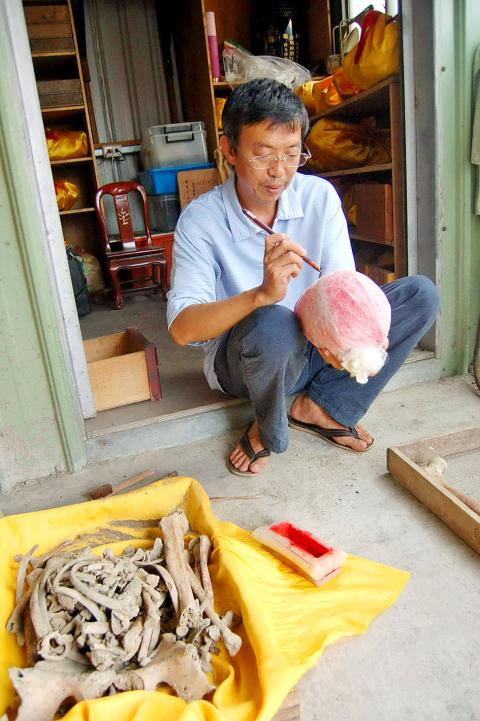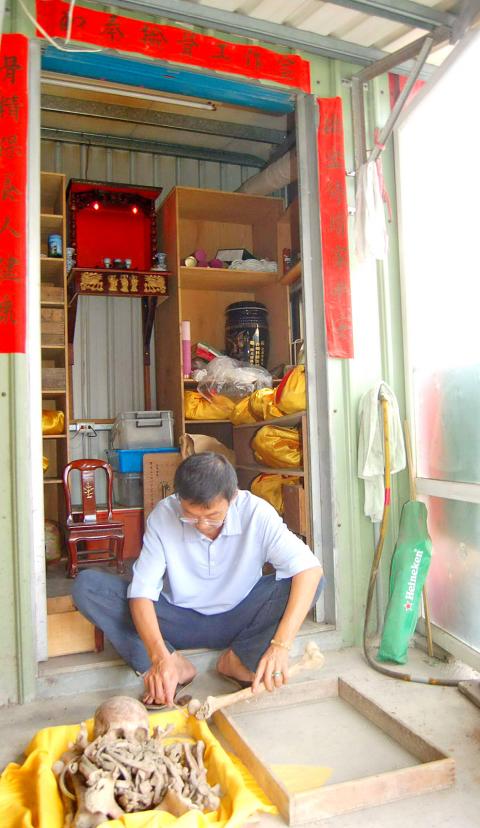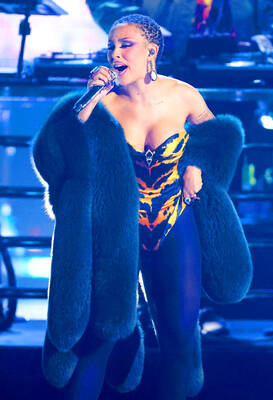Wu Tsai-li is all business as he leans over a pile of human bones that he’s just dumped on top of a grave, and begins to arrange them back into a vaguely skeletal form.
Wu is in the process of performing a rite of ancestor worship called “picking up the bones.” A part of a ritual generally known as double or second burial, the bones are placed in an urn with the skull at the top. The urn is then re-interred in the ancestral tomb.
Common in Taiwan for over two centuries, the custom has its origins in China’s Fujian Province. When farmers and merchants began migrating to Taiwan in the 17th century, they brought with them their custom of second burial. Over time, the tradition began to spread in Taiwan as it was an inexpensive way of sending the bones back to Fujian for burial in the ancestral tomb.

Photo: Liu Hsiao-hsin, Liberty Times
照片︰自由時報記者劉曉欣
However, as their roots sank deeper into the nation’s soil and people from Fujian began to regard Taiwan as their home, the process of returning the urns to China ceased as family plots were established in Taiwan.
The process, which has changed very little over the centuries, begins with the first burial taking place almost immediately after death. Regarded as a temporary grave, the body remains underground for at least seven years.
The length of time allows the flesh to decompose, making it easier for Wu, a “bone-picking” master, to clean the remaining flesh so that all that is left are the bones. After the flesh is removed, the bones are set out under the sun for three days to dry. They are then “picked up” and placed into the urn, and returned to the family gravesite.

Photo: Liu Hsiao-hsin, Liberty Times
照片︰自由時報記者劉曉欣
If it happens that the flesh hasn’t achieved a level of decomposition suitable for cleaning, Wu sprinkles rice wine over the corpse and dresses it with the leaves of six heads of cabbage. The body is then re-interred. The concoction is enough to ensure sufficient decomposition after an additional three months.
The reason for such an elaborate procedure, Wu says, is that the soul adheres to the bones and not the flesh. This is why the flesh is dispensed with and the bones are re-buried after cleaning.
(Noah Buchan, Taipei Times)

Photo: Liu Hsiao-hsin, Liberty Times
照片︰自由時報記者劉曉欣
吳財立莊重肅穆地俯身向前,面朝著他剛剛倒在墓地上的一堆人骨,開始進行整理,重新排列成一組模糊的骨骸。
吳財立正在進行祭拜祖先的一項儀式,稱為「揀骨」。在這項通常又稱「二次葬」的儀式中,祖先遺骨會被安放在金斗甕中,頭骨放在最上方,再將金斗甕重新葬入祖墳中。
超過兩世紀以來,在台灣廣泛可見的這項習俗,源自於中國的福建省。隨著當地農民與商賈人士在十八世紀移居台灣,他們將「二次葬」的習俗也帶了過來。時光荏苒,這項傳統逐漸盛行於台灣各地。主要的原因在於,當時的先人如果想將祖先遺骨送回福建,葬入祖墳,這種方式並不算昂貴。

Photo: Liu Hsiao-hsin, Liberty Times
照片︰自由時報記者劉曉欣
不過,隨著先人逐漸深入扎根於台灣的土地,來自福建的移民也開始視台灣為家鄉,將金斗甕送回中國的習俗遂逐漸式微,人們也在台灣建起自己家的祖墳。
幾世紀以來,撿骨儀式的過程並沒有太大的改變。首先是一次葬,幾乎在過世後馬上開始進行。接下來遺體會在地下待上起碼七年,這段時間的墳墓則被視為暫時性的。
時間的長度會讓肉體逐漸分解,也使撿骨師傅吳先生更容易清理殘留的身體組織,最後只留下骨頭。徹底清除餘肉後,再將骨頭鋪在太陽底下曝曬三天,進行乾燥,接著便是「撿骨」,放入金斗甕,再重新葬回家族墓園。
萬一發生肉體還未達到適合清理的腐化程度時,吳師傅會在屍身上灑下米酒,再用六顆高麗菜裹住,再度葬回土中。米酒和高麗菜混合的成份足以確保腐化效率,再等三個月後就能重新撿骨。
根據吳師傅的說法,如此複雜的程序,背後原因在於靈魂附著於骨骸而非肉體上。這也就是為什麼肉體最後會被捨去,而骨骸則會在清理後重新下葬。
(台北時報章厚明譯)

A: Apart from the Taipei Music Center’s exhibit and concert, US pop rock band OneRepublic and rapper Doja Cat are touring Kaohsiung this weekend. B: OneRepublic is so popular that after tonight’s show at the K-Arena, they are set to return to Taiwan again in March next year. A: And Doja will also perform at the same venue on Sunday, right? B: Yup. Her collab with Blackpink’s Lisa and singer Raye for the song “Born Again” has been a huge worldwide success. A: Doja even made it on Time magazine’s “100 Most Influential People” list in 2023. She’s so cool. A: 本週末除了北流的特展和演唱會外,美國男團共和世代和饒舌歌手蜜桃貓朵佳也將來台開唱。 B: 共和世代因太受歡迎,繼今晚高雄巨蛋的演唱會後,預計明年3月即將再度來台巡演唷。 A: 朵佳本週日將在同場地開唱,對不對?

Tango unfolds in a dimly lit room, where a haunting melody ushers two dancers into a close embrace. Here, music and movement merge into a silent yet passionate conversation, expressing longing, memory and shared purpose. What makes tango truly magical is the deep interaction and spontaneous improvisation between partners. Tango began in the late 19th century in Buenos Aires, Argentina’s bustling capital. Born in the poor working-class neighborhoods and busy port areas, this dance emerged from a melting pot of cultures. European immigrants, African slaves and local residents all contributed to its unique character. From these rich influences, tango

A: What show are you watching online? B: I’m watching “Fly Me to the Moon & Back” – an exhibition launched by the Taipei Music Center (TMC) to commemorate the late singer Tom Chang. A: Known for his sky-high notes, Chang is praised as one of the best singers in the 1990s. His death at the age of 31 was a major loss indeed. B: And I’m so glad that we went to the TMC’s 90s-themed concert last Friday. I finally saw the iconic “Godmother of Rock” WaWa perform live. A: This year-end show also featured singers Princess Ai, Bii, Wayne Huang, PoLin and

Just like fingerprints, your breathing patterns may serve as a definitive identifier. In a recent study, scientists have demonstrated an astonishing 96.8% accuracy in identifying individuals based on their respiratory patterns. This revelation could open up new possibilities in biometrics and personalized health monitoring. The notion of using individual breathing patterns as a distinct biological signature has long been a topic of discussion within the respiratory science community, yet a practical method for measurement remained elusive. This changed with the invention of a tiny, wearable device capable of extended recording. Researchers deployed a lightweight tube designed to fit inside